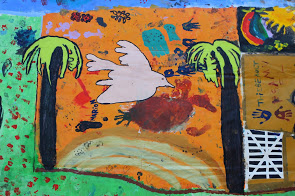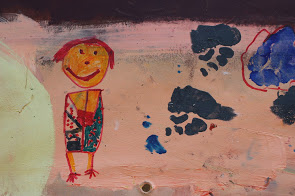Graines de paix 2014

Mural painted by children suffering from epilepsy 2014
"Faire autre chose avec son corps que des crises d'épilepsie"
C’est ce que propose régulièrement toute l’équipe éducative et médicale du COCEE aux enfants épileptiques dont ils s’occupent toute l’année. Cette fois c’est un projet arts plastiques qui va les amener à s’interroger sur ce que représente la paix pour eux ; parce que si l’épilepsie n’est pas une guerre, c’est tout de même un combat, le combat de ces enfants pour avoir le droit d'exister.
A l’heure où l’éducation, la culture et les pratiques artistiques ont la vie dure, ce film rappelle l’intérêt éducatif, médical et psychologique de la mise en place d’un projet artistique, notamment avec des enfants malades."

|
|
|
|
|
|
|
|
|
|
|
|
|
|
|
|
|
|
|
|
|
|
|
|
|
|
|
|
|
|
Epilepsy was well described by Dostoevsky who suffered himself from this. In his novel 'the idiot' he implies that this may be the result of staying always outside the circuit of love. The idiot would love people so much that he would be able to bring together a man and a woman who would then fall in love with one another, but never he himself could enter such a love relationship. That indescribable agony left a deep impression upon many readers of Dostoevsky's novel without ever being able to say exactly why. But this writer was able to recognize and touch upon emotions which go otherwise in society unrecognized.
KGGY actions are based on 'collaborative learning'
|
|
|
|
|
|
|
|
|
|
|
|
Details of the mural
|
|
|
|
|
|
|
|
|
|
|
|
|
|
Group looking at the now completed mural and mounted on a wall |
|
|
|
|
|
|
|
Alexandra Zanne |
|
Photos: Alexandra Zanne
Text: Alexandra Zanne and Hatto Fischer
Imagines were uploaded July 13, 2014
Film by Alexandra Zanne of the action: http://vimeo.com/111192160
Comments:
26.11.2014
Dear Alexandra,
I just looked at this wonderful film of yours. Traces can be seen everywhere. Interesting I find how many of the children wanted to make borders, or just paint some surface with one colour. A possible yearning for one feat, one accomplishment, one touch! How the two enjoyed splashing their hands on the canvas and then the girl in a daring move made her hand print on the sweater and stomach of the boy next to her. They both laughed. And in the end the one girl would say "il est tres grande!" Indeed, grande has a double meaning. Beautiful the trees with that moon behind. Incredible the details which you picked up with your camera. As always you love to work low to the ground. So you can follow the movement of the hands and then let the camera trace slowly the flow of colours. Thanks for bringing through the film much closer to me as a viewer the world of these exceptional children. Altogether you managed a much softer film than ever before. It contains lovely touches and good angles. I like especially when you interview this young girl and let one see her hair against the sunlight flooding into the room through the window behind her. That is another juxtaposition to the canvas and what the children tell in their own words or rather ways of painting on a huge canvas.
Just wonderful.
hatto
The film made by Alexandra Zanne can now be seen with English sub-titles at
From Ravenna, Italy
Friday, 12. December 2014
Stefanie Moschana
Comment from Paris, France
16.12.2014
Dear Hatto and Alexandra,
Thank you for the link. It is such a touching film ! It is true that art can covey hidden feelings, which sometimes we cannot show or tell directly. I couldn't watch the film for the first time without stopping it and repeating parts of it over and over again for it triggered all my senses and moved me… Some parts left a smile on my face for few seconds, some left the expression of amazement, and others left me with thoughts and questions.
It is incredible how proud, happy, confident, and honest, the children felt while painting, or even scribbling, as the little boy said. His words were strong and meaningful; he could understand that some of the other children have a more serious situation that his, and he was defending them and giving reasons and explanations for the way they drew. WAW!
Those children were painting, laughing, playing and collaborating with one other even though they were sometimes struggling with their own selves. I believe that children understand the meaning of peace more than adults do because they just act with peace without thinking of the dimensions of the word itself. The meaning is within them; it is in their acts, laughs and innocent behavior. On the other hand, adults think of peace in all different ways and try to analyze it and find ways to accomplish it, which makes the act of accomplishment harder. Whereas with children peace is approached in a natural manner, while they are speaking with honesty, while they are reacting with pure hearts, and while they are collaborating and playing together. To me this is real peace. Now the question that asks it self is how can adults approach peace the same way children do? And I ask how, because adults tend to analyze, explain and justify things before finding the "right" answer, or reaction, which may not be "right" after all.
Indeed, battles are not found just in war. In fact, they are found in everyday life, in people with special needs, in people who suffer..
Each KGGY project gives me new thoughts, enlightens me more and inspires me a lot. Thank you for that great project !
As for the meeting in Berlin, hopefully I will be able to come. I started putting ideas and contacting people for a future KGGY project in Lebanon in the summer of 2015.
Valia Mhaish
She is co-ordinator of the Kids' Guernica - Guernica Youth project in Tripoli, Lebanon August 2014 when a mural called "To remember we need to forget" was created to commerate the dead who had been killed by bomb blasts of two mosques in Tripoli 2013.
« Overview by Sara Minkara | Actions of Guernica Youth »



























